Opening of the line through Gateshead East
Rivalry between Newcastle upon Tyne and Gateshead is longstanding and probably pre-dates Newcastle’s unsuccessful attempt in the reign of Queen Elizabeth I to annexe its neighbour. In the nineteenth century Gateshead appeared on the railway map before Newcastle, as the Newcastle & Carlisle (N&C) Railway opened its riverside eastern terminus at Redheugh, in Gateshead, on 1 March 1837. A ferry connection across the River Tyne was provided to a rail-less ‘station’ in Newcastle. Redheugh remained as a passenger terminus after the N&C reached Newcastle, but with an intermittent service, closing on 30 August 1850. The Newcastle & Darlington Junction Railway opened a Gateshead terminus at Oakwellgate on 5 September 1839, but closed it on 2 August 1844 when trains were diverted to a magnificent new terminus at Greenesfield, which had opened on 19 June 1844.
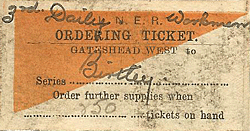 North of the Tyne, the building of George Hudson’s Newcastle & Berwick Railway was under way in the late 1840s, but the High Level Bridge over the Tyne between Gateshead and Newcastle, which would allow through running from London to Newcastle, was suffering delays. So as not to have his north-south route blocked at the Tyne, Hudson had the bridge scaffolding extended on the east side to make a temporary wooden viaduct which trains could use from the end of August 1848. The official opening ceremony for the permanent High Level Bridge was on 28 September 1849. The road deck, below the railway, opened early in 1850. It is possible that trains called at the Gateshead end of the temporary bridge to collect or deposit passengers. North of the Tyne, the building of George Hudson’s Newcastle & Berwick Railway was under way in the late 1840s, but the High Level Bridge over the Tyne between Gateshead and Newcastle, which would allow through running from London to Newcastle, was suffering delays. So as not to have his north-south route blocked at the Tyne, Hudson had the bridge scaffolding extended on the east side to make a temporary wooden viaduct which trains could use from the end of August 1848. The official opening ceremony for the permanent High Level Bridge was on 28 September 1849. The road deck, below the railway, opened early in 1850. It is possible that trains called at the Gateshead end of the temporary bridge to collect or deposit passengers.
The first station at Gateshead East
When the full ‘main line’ service was introduced across the High Level Bridge both of the existing Gateshead termini, Greenesfield and Redheugh, closed to passengers, and a station was provided in their stead a short distance south-east of the High Level Bridge. It took the form of a narrow island platform, squeezed between the two tracks as they curved tightly on a series of stone arches. Its facilities were limited to a small entrance block, probably on the east side, and were greatly inferior to the elegant building with a trainshed that Greenesfield had possessed. In 1862 a trainshed was added to the new station to provide some comfort for the passengers on the elevated, windswept platform. This is the station which would become Gateshead East when its neighbour was added in 1868.
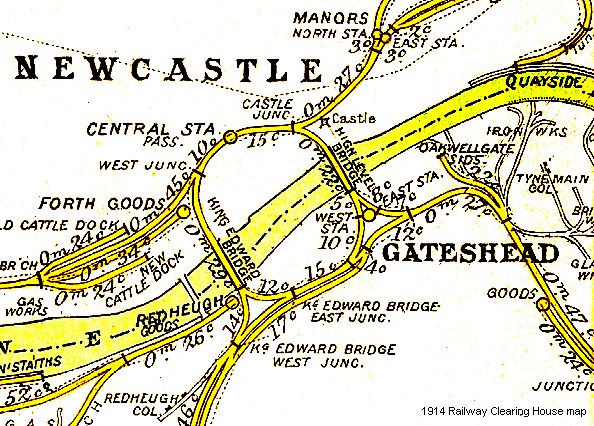
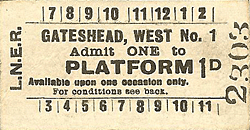 The opening of Gateshead West (1868) The opening of Gateshead West (1868)
The North Eastern Railway (NER) was formed by the amalgamation of several companies, including the York, Newcastle & Berwick. In 1868 the NER opened a Durham to Newcastle route via Team Valley – goods services had begun nine months earlier – and this line approached Newcastle by the High Level Bridge. Two further platforms were constructed at Gateshead as part of this scheme, on a sharp south-west to north-east curve, adjacent to the existing station. The new platforms were generally known as Gateshead West, although the suffix was not always used, and in many respects the stations were one: for example, their ticket sales figures were combined. On its up (southbound) platform Gateshead West possessed a single-storey office and waiting room range, built of sandstone. Most of its window openings were rounded arches, but beneath two pediments were wider segmental arches. A trainshed with a low-angled pitched roof sheltered the platforms. The down platform possessed a screen wall with rounded-arch openings, which supported the trainshed. From 15 January 1872 East Coast main line trains were routed through Gateshead West when the Durham – Ferryhill line opened; previously the trains had followed the ‘Old Main Line’ Leamside route and passed through Gateshead East.
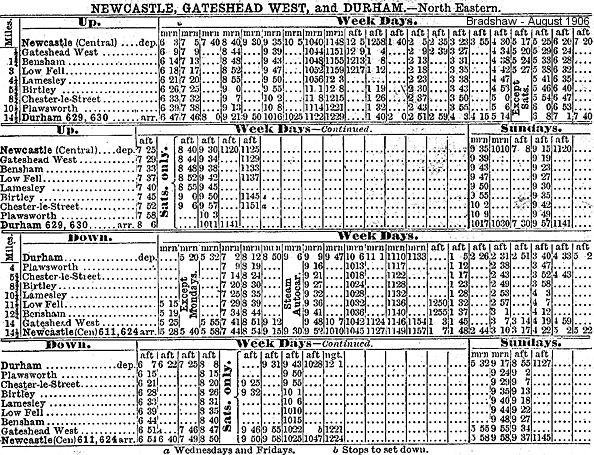
Reconstruction of Gateshead East (1884-86)
In 1884-86 the inadequate Gateshead East station was reconstructed by the NER, widening the north-east side of the viaduct so that two generously proportioned side platforms built of timber could replace the island, and a substantial building containing all of the station facilities was placed behind the up platform. The down platform had only a screen of timber and glass. A trainshed was built, its arched profile contrasting with the ridged design used for the West station. South-east of the trainshed the down platform, which extended many yards beyond its neighbour, was sheltered by a canopy. At the north-west end of the station, the up platform extended further than the down platform, the latter being curtailed by the junction with the line through Gateshead West. Passengers entered from Wellington Street, south-west of the East station, where a ‘suitable aggrandised façade’ (Fawcett) was provided, then passed under both tracks through one of the viaduct arches, before ascending a staircase to the up platform. Entry to the platform was controlled by elegant iron barriers. Facing the platform, the upper storey of the building had segmental-arched windows with matching door openings. In LNER days a ‘passimeter’ booking office was added. A further entrance was available between Half Moon Lane and Hills Street, and a newspaper article of 1884 refers to access from Bankwell Lane. An iron footbridge connected all four platforms where they converged at their northern end.
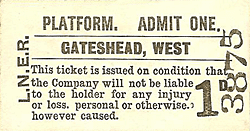 Gateshead East and West train services Gateshead East and West train services
Gateshead East and West stations were clearly of much lower status than Newcastle Central, which handled inter-city traffic and was the hub of the Tyneside railway network. Despite their catchment area being limited by their riverside position, the Gateshead stations were close to the town’s shopping centre and to riverside industries and were heavily used in the early twentieth century, issuing 491,200 tickets in 1911. At the turn of the century Gateshead enjoyed frequent services with more than a hundred departures from the East station and over 30 from Gateshead West. Trains on the South Shields and Sunderland routes and a few on the Washington – Leamside line called at Gateshead East, while the West station handled services to Durham, the Consett / Blackhill line, and (from 1909-18 and 1919-26) the Dunston branch. On 1 October 1906 the King Edward Bridge opened, allowing East Coast main line trains to pass through Newcastle without the reversal that was necessary when using the High Level Bridge. Consequently most main line trains ceased to pass through Gateshead West.
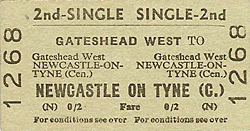 In the late 1930s Gateshead West still enjoyed a respectable number of departures, but the first British Railways North Eastern Region timetable (summer 1948) showed that Blackhill trains no longer called, and there were only two weekday departures in each direction, with none on Sunday; from 1951 southbound trains ceased to call at Gateshead West. Meanwhile Gateshead East had some 160 departures on weekdays, including a 20-minute interval service of electric trains to and from South Shields. Although recommendations had been made in the early years of the twentieth century for Newcastle – South Shields electrification, and the ‘North Tyneside’ routes between Newcastle and Whitley Bay were electrified on the third rail system in 1904-09, the South Shields service had to wait until 14 March 1938. The electric stock for the service was 1920/22-built units which had operated in North Tyneside, and these soldiered on until 1955 when Eastleigh-built ‘Southern Region’ units replaced them. In the late 1930s Gateshead West still enjoyed a respectable number of departures, but the first British Railways North Eastern Region timetable (summer 1948) showed that Blackhill trains no longer called, and there were only two weekday departures in each direction, with none on Sunday; from 1951 southbound trains ceased to call at Gateshead West. Meanwhile Gateshead East had some 160 departures on weekdays, including a 20-minute interval service of electric trains to and from South Shields. Although recommendations had been made in the early years of the twentieth century for Newcastle – South Shields electrification, and the ‘North Tyneside’ routes between Newcastle and Whitley Bay were electrified on the third rail system in 1904-09, the South Shields service had to wait until 14 March 1938. The electric stock for the service was 1920/22-built units which had operated in North Tyneside, and these soldiered on until 1955 when Eastleigh-built ‘Southern Region’ units replaced them.
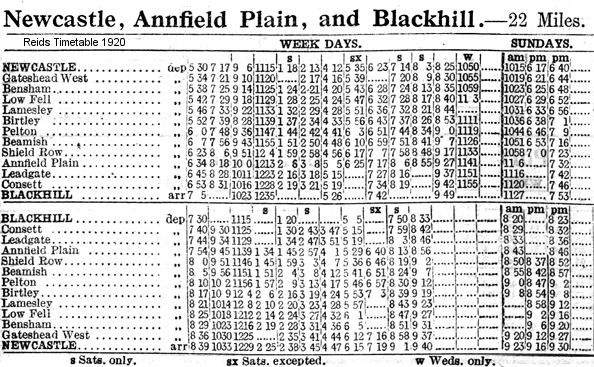
Ticket bookings at the Gateshead stations fell from almost half-a-million in 1911 to 134,246 in 1951.
Closure of Gateshead West (1965)
Gateshead West’s negligible train service persisted into the 1960s and, although the station was not listed for closure in the Reshaping of British Railways (‘Beeching Report’) of March 1963, on 26 March 1965 British Rail (BR) proposed its closure. The Transport Users’ Consultative Committee report of 22 July 1965 stated that, despite there being only one train per day (northbound at 08.34 on weekdays and 14.28 on Saturdays) there were 16 regular passengers. A census on Saturday 24 October 1964 noted, however, that no-one joined or alighted from the single train. Only one objection to closure was received, from a Mr Potts of Chester-le-Street who used the weekday train to alight at Gateshead West. Ominously, the station appeared only as a timetable footnote in June 1965, and its closure was approved, with effect from 1 November 1965. It is not known exactly when the trainshed was removed, but it had gone by April 1966.
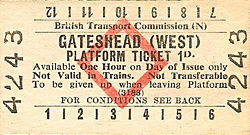 Gateshead East in the 1960s Gateshead East in the 1960s
Gas lighting at the Gateshead stations gave way to electricity in LNER or early-BR days. The East station lighting had brick-shaped diffusers displaying the station name (just ‘Gateshead’) and until about 1962 LNER running-in boards were retained, when BR installed vitreous enamel nameboards and miscellaneous information signs, but not totems.
Steam-haulage of trains through Gateshead East between Newcastle and Middlesbrough gave way to diesel multiple units (DMUs) in November 1955, and the Sunderland local trains followed in August 1958. In a retrogressive move the electric train services between Newcastle and South Shields gave way to DMUs on 7 January 1963. BR reported in 1962 that since their introduction in 1938 passenger loadings on the electric service had halved, and that diesel operation would be cheaper. North Tyneside electrics were withdrawn in favour of DMUs in 1966-67. The South Shields service suffered further economies when winter Sunday trains were discontinued in 1964-65, and in summer 1965 when the 20-minute weekday frequency was reduced to half-hourly. Sunday trains on the South Shields service ceased altogether in winter 1979-80.
Until 1966 a passenger from Newcastle to South Shields or Sunderland was treated to a magnificent view of the River Tyne gorge from the High Level Bridge, before plunging into the cavernous trainshed at Gateshead East. In that year both the trainshed and the down platform canopy were removed, after which the station was no longer dark and forbidding, but bleak and equally uninviting; a coat of white paint on the platform elevation of the station building did little to improve its appearance. On 2 January 1967 the North Eastern Region was abolished and its lines and stations were transferred to Eastern Region management. In that year ticket bookings at Gateshead East, at 68,629 were only half of the 1951 figure. The Newcastle – Sunderland and South Shields branch local services were among those changed by the Eastern Region to ‘Paytrain’ operation in which, as an economy measure, booking offices were closed at all but the most important stations and tickets were issued instead by conductor-guards on the train. Gateshead East and all of the other intermediate stations between Newcastle and Sunderland / South Shields consequently became unstaffed on 5 October 1969. Windows and doors in the main building which opened onto the up platform were bricked up, and the former stationmaster’s office in a timber building standing above the road entrance to the High Level Bridge, between the East and West stations, was dismantled. Although the purpose of the timber building was presumably altered after the withdrawal of staff, the structure was in situ and in good condition during the 1970s.

Gateshead East: the final years
Following the removal of the trainshed, the up platform, where few passengers would be likely to gather for trains to Newcastle, had nowhere for passengers to take refuge from the elements, but in 1971/2 a crude breezeblock shelter was placed on the down platform. At that time only one running-in board on each platform showed the station’s name. In 1974/75 BR Eastern Region provided new lighting and signage, consisting of tall and widely spaced lamp posts - replacing some less conspicuous temporary lighting installed when the trainshed was removed - with Corporate Identity nameplates fixed to them.
From 1 May 1972 the timetables acknowledged that there was no longer a Gateshead West station, and the ‘East’ suffix was dropped.
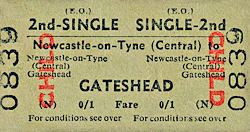 The Tyne and Wear Metro scheme, which received the Royal Assent in 1973, included a new bridge over the River Tyne, a station conveniently sited under central Gateshead, and the adoption of most of the South Shields branch as part of the light rail network. Although local British Rail trains would continue to pass through Gateshead (East) on the Sunderland line, it was proposed to close the station since a more frequent service would be provided at the underground Gateshead station. The likelihood of its eventual closure clearly deterred British Rail from investing in Gateshead (East) station from the mid 1970s onwards. An article in Evening Chronicle on 18 November 1976 drew attention to the shocking state of the station and the failure of BR to advertise its existence. Despite its elevated position above the town’s streets a local resident commented, ‘it doesn’t look like a station because there is no outward sign that gives a clue’, whilst another complained, ‘local residents get fed up with people asking them where the station is; some even ask when they are only a hundred yards from it’. The journalist, Gerry Rothapel, who compiled the article, remarked that ‘for a service that runs eight trains every hour during off-peak periods to South Shields and Sunderland, people think that there is a case for a more caring attitude from British Rail’ and added that Councillor Stephen Nugent, a former Mayor of Gateshead and Chairman of Gateshead Transport Advisory Committee, believed that the station ‘certainly did not fit the town’. For those determined intending passengers who eventually found the station, the explosion of graffiti that greeted them from the moment they entered accompanied them up the 33 steps to the platform where the walls of the shelter were liberally daubed, and tin cans and discarded sweet papers littered the floor in an air of almost total dereliction. The Tyne and Wear Metro scheme, which received the Royal Assent in 1973, included a new bridge over the River Tyne, a station conveniently sited under central Gateshead, and the adoption of most of the South Shields branch as part of the light rail network. Although local British Rail trains would continue to pass through Gateshead (East) on the Sunderland line, it was proposed to close the station since a more frequent service would be provided at the underground Gateshead station. The likelihood of its eventual closure clearly deterred British Rail from investing in Gateshead (East) station from the mid 1970s onwards. An article in Evening Chronicle on 18 November 1976 drew attention to the shocking state of the station and the failure of BR to advertise its existence. Despite its elevated position above the town’s streets a local resident commented, ‘it doesn’t look like a station because there is no outward sign that gives a clue’, whilst another complained, ‘local residents get fed up with people asking them where the station is; some even ask when they are only a hundred yards from it’. The journalist, Gerry Rothapel, who compiled the article, remarked that ‘for a service that runs eight trains every hour during off-peak periods to South Shields and Sunderland, people think that there is a case for a more caring attitude from British Rail’ and added that Councillor Stephen Nugent, a former Mayor of Gateshead and Chairman of Gateshead Transport Advisory Committee, believed that the station ‘certainly did not fit the town’. For those determined intending passengers who eventually found the station, the explosion of graffiti that greeted them from the moment they entered accompanied them up the 33 steps to the platform where the walls of the shelter were liberally daubed, and tin cans and discarded sweet papers littered the floor in an air of almost total dereliction.
Despite local dissatisfaction, no significant improvements were made to Gateshead (East) station.

From 5 November 1979 the two stations following Gateshead en route to South Shields / Sunderland - Felling and Pelaw - were closed and Heworth opened midway between them. However Gateshead outlived them for only two years, as on 15 November 1981 the Metro opened to Heworth as the first stage of the South Shields extension, and Gateshead (East) closed a week later on 22 November 1981. The new Metro station under central Gateshead proved popular, handling over seven million passengers in 1985 – substantially more than the station that it replaced.
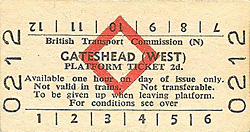 Gateshead East remained substantially intact until it was damaged by fire in the late 1980s, and by 1990 the platforms and the track-level buildings had been demolished. The only remnant of the station is the Wellington Street entrance, used as a kebab shop. The subway to which it led forms the shop premises with a wall at the back where the steps to the up platform began. The east side of the elevated railway has a rather tasteful confectionery of brick and stone. Ironically, the platforms remain intact at Gateshead West half a century after the station closed. Gateshead East remained substantially intact until it was damaged by fire in the late 1980s, and by 1990 the platforms and the track-level buildings had been demolished. The only remnant of the station is the Wellington Street entrance, used as a kebab shop. The subway to which it led forms the shop premises with a wall at the back where the steps to the up platform began. The east side of the elevated railway has a rather tasteful confectionery of brick and stone. Ironically, the platforms remain intact at Gateshead West half a century after the station closed.
Gateshead now has the dubious distinction of being one of the largest towns not to have a station on the National Rail network, while Newcastle retains one of the country’s principal, and architecturally finest, stations.
Tickets from Michael Stewart except 0839 Brian Johnson. Reids & LNER timetables from Alan Young, Bradshaw from Chris Hind . Route map drawn by Alan Young. Click here to see LNER full service timetable for both stations for winter 1937/38. Click here for ECML BR North Eastern Region timetable winter 1965/66. This is the last timetable before closure. It shows the sole Monday-Friday departure from Gateshead West which has been relegated to a footnote.
Sources:
- Addyman, John and Fawcett, Bill The High Level Bridge and Newcastle Central Station (NERA 1999)
- Cook, R A and Hoole, K North Eastern Railway historical maps (RCHS second edition 1991)
- Fawcett, Bill A history of North Eastern Railway architecture (Three volumes) (NERA 2001-05)
- Guy, Andy Steam and speed (Tyne Bridge Publishing 2003)
- Hoole, Ken A regional history of the railways of Great Britain: vol 4 The North East (David & Charles 2nd edition 1974)
- Hoole, Ken Railway stations of the North East (David & Charles 1985)
- Quick, Michael Railway Passenger Stations in Great Britain a Chronology (RCHS 2009)
- Young, Alan Suburban railways of Tyneside (Martin Bairstow 1999)
- Young, Alan Lost stations of Northumberland & Durham (Silver Link 2011)
- Hansard Various (HMSO)
- Evening Chronicle Article on 18 November 1976
See also: Gateshead East |

west_old2.jpg)
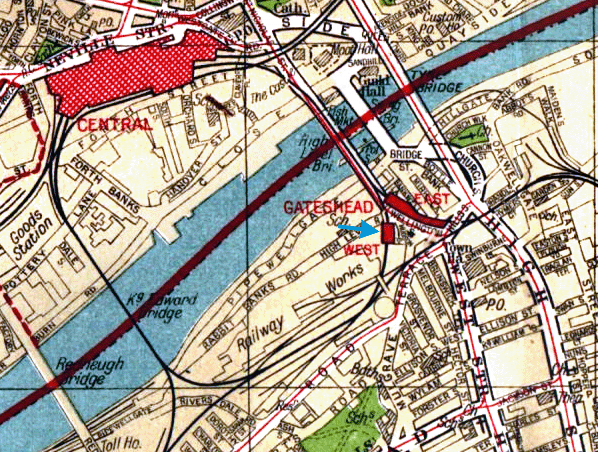
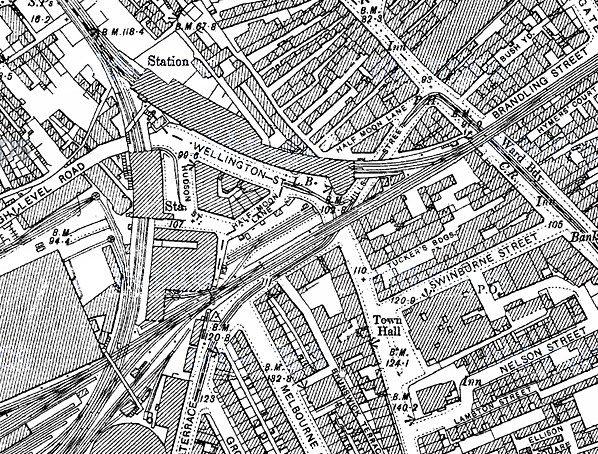
.gif)
west_old9.jpg)
west_old10.jpg)
west_old8.jpg)
west_old9.jpg)
west_old13.jpg)
west_old6.jpg)
west_old12.jpg)
west_old1.jpg)
west_old11.jpg)
west20.jpg)
 North of the Tyne, the building of George Hudson’s Newcastle & Berwick Railway was under way in the late 1840s, but the High Level Bridge over the Tyne between Gateshead and Newcastle, which would allow through running from London to Newcastle, was suffering delays. So as not to have his north-south route blocked at the Tyne, Hudson had the bridge scaffolding extended on the east side to make a temporary wooden viaduct which trains could use from the end of August 1848. The official opening ceremony for the permanent High Level Bridge was on 28 September 1849. The road deck, below the railway, opened early in 1850. It is possible that trains called at the Gateshead end of the temporary bridge to collect or deposit passengers.
North of the Tyne, the building of George Hudson’s Newcastle & Berwick Railway was under way in the late 1840s, but the High Level Bridge over the Tyne between Gateshead and Newcastle, which would allow through running from London to Newcastle, was suffering delays. So as not to have his north-south route blocked at the Tyne, Hudson had the bridge scaffolding extended on the east side to make a temporary wooden viaduct which trains could use from the end of August 1848. The official opening ceremony for the permanent High Level Bridge was on 28 September 1849. The road deck, below the railway, opened early in 1850. It is possible that trains called at the Gateshead end of the temporary bridge to collect or deposit passengers. 
 The opening of Gateshead West (1868)
The opening of Gateshead West (1868)
 Gateshead East and West train services
Gateshead East and West train services In the late 1930s Gateshead West still enjoyed a respectable number of departures, but the first British Railways North Eastern Region timetable (summer 1948) showed that Blackhill trains no longer called, and there were only two weekday departures in each direction, with none on Sunday; from 1951 southbound trains ceased to call at Gateshead West. Meanwhile Gateshead East had some 160 departures on weekdays, including a 20-minute interval service of electric trains to and from South Shields. Although recommendations had been made in the early years of the twentieth century for Newcastle – South Shields electrification, and the ‘North Tyneside’ routes between Newcastle and Whitley Bay were electrified on the third rail system in 1904-09, the South Shields service had to wait until 14 March 1938. The electric stock for the service was 1920/22-built units which had operated in North Tyneside, and these soldiered on until 1955 when Eastleigh-built ‘Southern Region’ units replaced them.
In the late 1930s Gateshead West still enjoyed a respectable number of departures, but the first British Railways North Eastern Region timetable (summer 1948) showed that Blackhill trains no longer called, and there were only two weekday departures in each direction, with none on Sunday; from 1951 southbound trains ceased to call at Gateshead West. Meanwhile Gateshead East had some 160 departures on weekdays, including a 20-minute interval service of electric trains to and from South Shields. Although recommendations had been made in the early years of the twentieth century for Newcastle – South Shields electrification, and the ‘North Tyneside’ routes between Newcastle and Whitley Bay were electrified on the third rail system in 1904-09, the South Shields service had to wait until 14 March 1938. The electric stock for the service was 1920/22-built units which had operated in North Tyneside, and these soldiered on until 1955 when Eastleigh-built ‘Southern Region’ units replaced them.
 Gateshead East in the 1960s
Gateshead East in the 1960s
 The Tyne and Wear Metro scheme, which received the Royal Assent in 1973, included a new bridge over the River Tyne, a station conveniently sited under central Gateshead, and the adoption of most of the South Shields branch as part of the light rail network. Although local British Rail trains would continue to pass through Gateshead (East) on the Sunderland line, it was proposed to close the station since a more frequent service would be provided at the underground Gateshead station. The likelihood of its eventual closure clearly deterred British Rail from investing in Gateshead (East) station from the mid 1970s onwards. An article in Evening Chronicle on 18 November 1976 drew attention to the shocking state of the station and the failure of BR to advertise its existence. Despite its elevated position above the town’s streets a local resident commented, ‘it doesn’t look like a station because there is no outward sign that gives a clue’, whilst another complained, ‘local residents get fed up with people asking them where the station is; some even ask when they are only a hundred yards from it’. The journalist, Gerry Rothapel, who compiled the article, remarked that ‘for a service that runs eight trains every hour during off-peak periods to South Shields and Sunderland, people think that there is a case for a more caring attitude from British Rail’ and added that Councillor Stephen Nugent, a former Mayor of Gateshead and Chairman of Gateshead Transport Advisory Committee, believed that the station ‘certainly did not fit the town’. For those determined intending passengers who eventually found the station, the explosion of graffiti that greeted them from the moment they entered accompanied them up the 33 steps to the platform where the walls of the shelter were liberally daubed, and tin cans and discarded sweet papers littered the floor in an air of almost total dereliction.
The Tyne and Wear Metro scheme, which received the Royal Assent in 1973, included a new bridge over the River Tyne, a station conveniently sited under central Gateshead, and the adoption of most of the South Shields branch as part of the light rail network. Although local British Rail trains would continue to pass through Gateshead (East) on the Sunderland line, it was proposed to close the station since a more frequent service would be provided at the underground Gateshead station. The likelihood of its eventual closure clearly deterred British Rail from investing in Gateshead (East) station from the mid 1970s onwards. An article in Evening Chronicle on 18 November 1976 drew attention to the shocking state of the station and the failure of BR to advertise its existence. Despite its elevated position above the town’s streets a local resident commented, ‘it doesn’t look like a station because there is no outward sign that gives a clue’, whilst another complained, ‘local residents get fed up with people asking them where the station is; some even ask when they are only a hundred yards from it’. The journalist, Gerry Rothapel, who compiled the article, remarked that ‘for a service that runs eight trains every hour during off-peak periods to South Shields and Sunderland, people think that there is a case for a more caring attitude from British Rail’ and added that Councillor Stephen Nugent, a former Mayor of Gateshead and Chairman of Gateshead Transport Advisory Committee, believed that the station ‘certainly did not fit the town’. For those determined intending passengers who eventually found the station, the explosion of graffiti that greeted them from the moment they entered accompanied them up the 33 steps to the platform where the walls of the shelter were liberally daubed, and tin cans and discarded sweet papers littered the floor in an air of almost total dereliction.
 Gateshead East remained substantially intact until it was damaged by fire in the late 1980s, and by 1990 the platforms and the track-level buildings had been demolished. The only remnant of the station is the Wellington Street entrance, used as a kebab shop. The subway to which it led forms the shop premises with a wall at the back where the steps to the up platform began. The east side of the elevated railway has a rather tasteful confectionery of brick and stone. Ironically, the platforms remain intact at Gateshead West half a century after the station closed.
Gateshead East remained substantially intact until it was damaged by fire in the late 1980s, and by 1990 the platforms and the track-level buildings had been demolished. The only remnant of the station is the Wellington Street entrance, used as a kebab shop. The subway to which it led forms the shop premises with a wall at the back where the steps to the up platform began. The east side of the elevated railway has a rather tasteful confectionery of brick and stone. Ironically, the platforms remain intact at Gateshead West half a century after the station closed.
 Home Page
Home Page